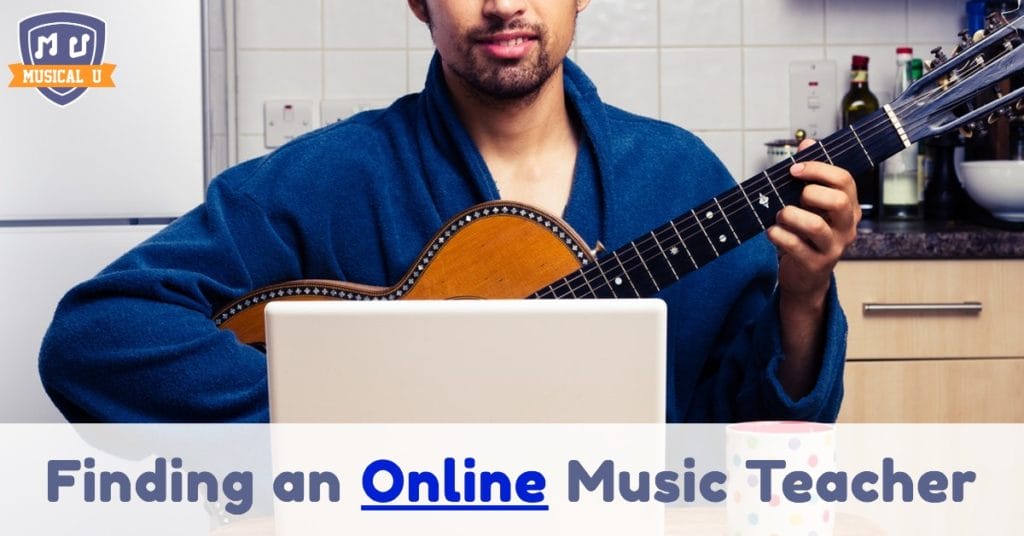Whether you’re a singer, a guitarist, or aren’t quite sure exactly what musical instrument you want to take up, a teacher is an invaluable resource. They can help you decide which path is the best for you, tailor their methods to your specific needs, and make sure that you get the most out of your lessons.
However, traditional in-person music lessons are not a one-size-fits-all model, and there’s various reasons why they may not be the best option for you.
Do you live in a rural area with no music schools around? Do you have a work schedule that leaves you little time to drive to a music lesson once a week? Do you have young children that you often need to be at home with? Do you already have a home studio set up, and would simply prefer not to travel for lessons?
Why Online Lessons?
Enter: an online teacher.
Online teachers use live video chat to work with their students. This means that there is a real person on the other end of your FaceTime/Skype/Google Hangout who is watching you, talking to you, teaching you. They can send or share resources electronically and give you feedback and guidance during the lesson. It’s like having a real life teacher in your home (except you get to take lessons in your pajamas).
An added benefit of online teachers is that they are typically less expensive. Since the teacher doesn’t have to pay overhead costs for a studio or for travel, they can charge less for the actual lesson. This is great if you are on a budget, or want to put more money towards saving up for that new flute.
Best of all, online lessons are just as effective or even more effective than in-person for many students, depending on their goals and learning style. For example, you can set up your camera to focus close-up on a specific part of your instrument or on your hands, so your teacher can correct your placement and technique.
How to Find an Online Teacher
In the age of the internet, our world has gotten much smaller. You no longer need to check out the local bulletin board for teacher ads, or ask your best friend’s grandmother for a recommendation.
Quite the opposite: there is a plethora of resources to find a music teacher. A quick search will pull up websites that have listings for teachers. Some websites, like TakeLessons, are dedicated to helping connect students and teachers. You can also search for individual music studios and see if any of their instructors happen to offer online lessons.
Types of Lessons
Not all types of online lessons are created equal. An individual teacher may be best for some, whereas others do better in a group class. Concurrently, some students love the ease and convenience of pre-recorded lessons. Let’s look at the pros and cons of each of these options:
One on One
Pros: An individual online teacher can offer you one-on-one assistance and guidance, ensuring you get exactly what you need from the lesson. They can tailor the lessons to your needs and can adjust the lesson plans as you go. If you have a question, they’re able to answer it immediately, and spend more or less time on various aspects of the lesson depending on your abilities.
Cons: Individual teachers are not always readily available. Teachers have lives and busy schedules as well, so finding a time that works for both of you may be a challenge.
Group Lessons

Cons: A downfall of group lessons, though, is that the instruction is not personalized. The speed of the class is determined by the group as a whole, so you might not get to move onto other topics as quickly as you’d like, or your question might not necessarily be answered.
Just Press “Play”
Pros: Pre-recorded lessons, such as those on YouTube, are perfect when you have a specific question and you’d like it answered immediately. YouTube has thousands of videos that focus on specific aspects of music learning, offer tips and tricks, or even teach you how to play a song. They’re always available no matter the day or time and are great for quick instruction.
Cons: Since they are pre-recorded, there isn’t a live teacher to help if you’re stuck on a particular concept and you don’t have the ability to ask questions.
Look at your musical needs and goals frankly and honestly, and assess which of these online options is likely to be a good fit. You may even find that a combination of all three types might just be the best way to go!
Choosing Your Teacher
Once you’ve narrowed down your search and are ready to choose a teacher, how do you know if that person is a good fit for you? Everyone has a different learning style, and each instructor has a different teaching style. It’s important to make sure that the two align, so that you can get the most out of your online lessons.
When choosing a teacher, determine what you need from the person. Examine teaching credentials, level of experience, availability, and overall personality. If your goal is to become a concert pianist, someone who is used to teaching beginner-level children probably won’t be the best fit for you. Similarly, if you’re looking to learn to play your favourite popular music, a teacher who specializes in teaching classical probably isn’t the way to go. Establish your goals and wants, and discuss them with your teacher before you begin taking lessons.
 When determining if you’ve made the right choice or if you’d like to switch teachers, ask yourself the following:
When determining if you’ve made the right choice or if you’d like to switch teachers, ask yourself the following:
- Do I look forward to my lessons?
- Do I leave my lessons feeling challenged and motivated?
- Is my instructor open to feedback?
- Does my instructor have my best interests at heart?
- Has my desire to play changed?
Your honest answers will let you know if the teacher you’ve chosen is the right one for you.
Setting the Scene
Once you’ve chosen your teacher, it’s time to start preparing for your lessons. Before your first lesson, make sure that you have a quiet space set up where you can completely focus on your lesson without distractions. Determine the best time of day for your lessons (your neighbors probably won’t appreciate you playing the drums at midnight), and communicate that with your teacher.
These days, video calling has become easy and smooth on multiple platforms and devices.
You and your teacher should discuss and agree on what platform you’d like to use for your lessons, whether it be Skype or FaceTime or any of the many other video platforms available. You will most likely need a computer or phone with a built-in camera and microphone, or a webcam. Test your video and microphone settings prior to your lesson so that you can begin right away.

You’ll want the lessons to go as smooth as possible, so make sure you have a decent internet connection. If you’re not sure how to do this, your online teacher is likely to be able to help – the most important thing is to communicate with them to make the process as easy and smooth as possible.
Getting Started
Your teacher is chosen, your computer and playing space is all set up, and you’re ready to go.
Remember: this is a music lesson, and it’s as important to be punctual and professional in an online setting as it is in-person. This will help establish rapport with your teacher from the start, and show them that you’re reliable, engaged, and ready to learn.
In return, your teacher will help you stay motivated, introduce you to new concepts and ways of playing, and maybe even become a friend and mentor.
So are you ready to give online music lessons a try?
Head over to TakeLessons.com: with a single search, you’ll find teacher candidates that match your location, availability, and budget – and with reviews and biographies on each teacher’s profile, you can find the perfect fit for you and your musical goals.








